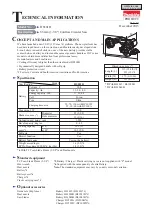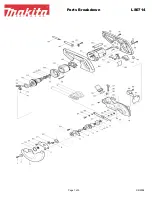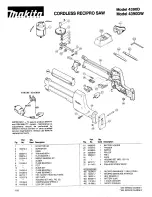
6
.
ALWAYS uSE SAW BLAdE guArd
, riving knife
and anti-kickback pawls for every through
–
sawing
operation. Through
–
sawing operations are those
in which the blade cuts completely through the
workpiece when ripping or crosscutting. Always be
sure blade guard is tightened securely.
.
ALWAYS HOLd WOrK fIrmLY
against the miter
gauge or rip fence. Use rip fence for rip cuts and
miter gauge for crosscuts. Never use miter gauge
and rip fence together.
3.
ALWAYS uSE
a push stick, especially when ripping
narrow stock. Refer to ripping instructions in this
Instruction Manual where the push stick is covered
in detail. A pattern for making your own push stick is
included on page 37.
4.
NEvEr pErfOrm ANY OpErATION frEEHANd,
which means using only your hands to support
or guide the workpiece. Always use either the
fence or the miter gauge to position and guide
the work.
frEEHANd cuTTINg IS THE mAJOr cAuSE Of
KICKBACK AND FINGeR/HAND AMPUTATIONS.
5.
NEvEr STANd
or have any part of your body in
line with the path of the saw blade. Keep your hands
out of the saw blade path.
6.
NEvEr rEAcH
behind or over the cutting tool for
any reason.
7.
rEmOvE
the rip fence when crosscutting.
8.
dO NOT uSE
a molding head with this saw.
9.
dIrEcTION Of fEEd.
feed work into a blade
against the direction of rotation of the blade.
0.
NEvEr
use the rip fence as a cut-off gauge when
crosscutting.
.
NEvEr ATTEmpT TO frEE A STALLEd SAW
BLAdE
without first turning the saw OFF and
unplugging saw from power source. Turn power
switch Off immediately to prevent motor damage.
.
prOvIdE AdEQuATE SuppOrT
to the rear
and the sides of the saw table for long or wide
workpieces.
3.
AvOId KIcKBAcKS
(work thrown back towards
you) by keeping the blade sharp, the rip fence
parallel to the saw blade and by keeping the riving
knife, anti-kickback pawls and guards in place,
aligned and functioning. Do not release work before
passing it completely beyond the saw blade. Do not
rip work that is twisted, warped or does not have a
straight edge to guide it along the fence.
4.
AvOId AWKWArd OpErATIONS
and hand
positions where a sudden slip could cause your
hand to move into the saw blade.
5.
NEvEr uSE SOLvENTS
to clean plastic parts.
Solvents could possibly dissolve or otherwise
damage the material. Only a soft damp cloth should
be used to clean plastic parts.
6.
mOuNT
your table saw on a bench or stand
before performing any cutting operations. Refer
to ASSEMBLY AND ADJUSTMENTS on page
4. Secure tool properly to prevent unexpected
movement.
7.
NEvEr cuT mETALS
or materials that may make
hazardous dust.
8.
ALWAYS USe IN A WeLL-VeNTILATeD AReA
.
Remove sawdust frequently. Clean out sawdust
from the interior of the saw to prevent a potential
fire hazard. Attach a vacuum to the dust port for
additional sawdust removal.
9.
NEvEr LEAvE THE SAW ruNNINg
uNATTENdEd
. Do not leave the saw until the blade
comes to a complete stop.
0. for proper operation follow the instructions in
this Instruction Manual entitled
ASSEmBLY ANd
AdJuSTmENTS
(Page 4). failure to provide
sawdust fall-through and removal hole will allow
sawdust to build up in the motor area resulting in a
fire hazard and potential motor damage.
.
uSE ONLY
saw blades recommended with warning
that the riving knife shall not be thicker than the
width of the groove cut by the saw blade and not
thinner than the body of the saw blade.
.
USe PUSH-STICK OR PUSH BLOCK
to feed the
workpiece past the saw blade. The push-stick
or push block should always be stored with the
machine when not in use.
TABLE SAW SAfETY
WArNINg
!
Содержание PCB222TS
Страница 11: ...11 A B C D E F G H I J K L M N O P Q UNPACKING YOUR JOBSITE TABLE SAW R S T U V ...
Страница 38: ...43 NOTEs ...







































